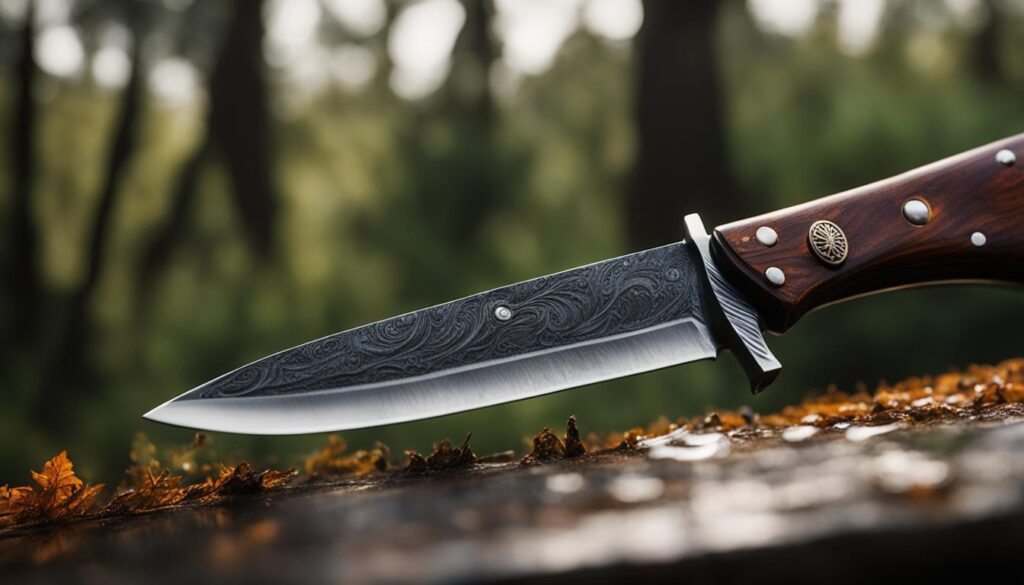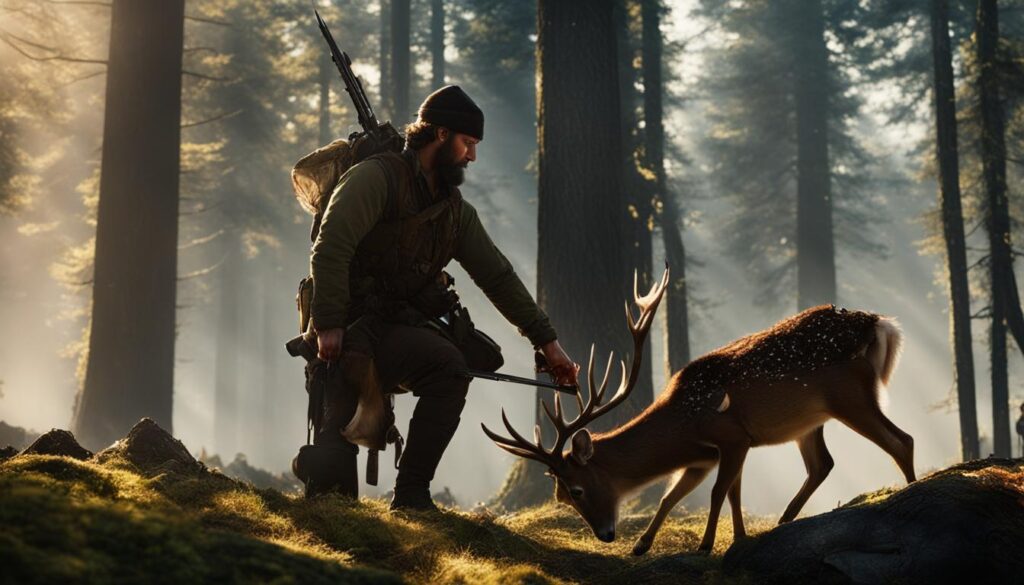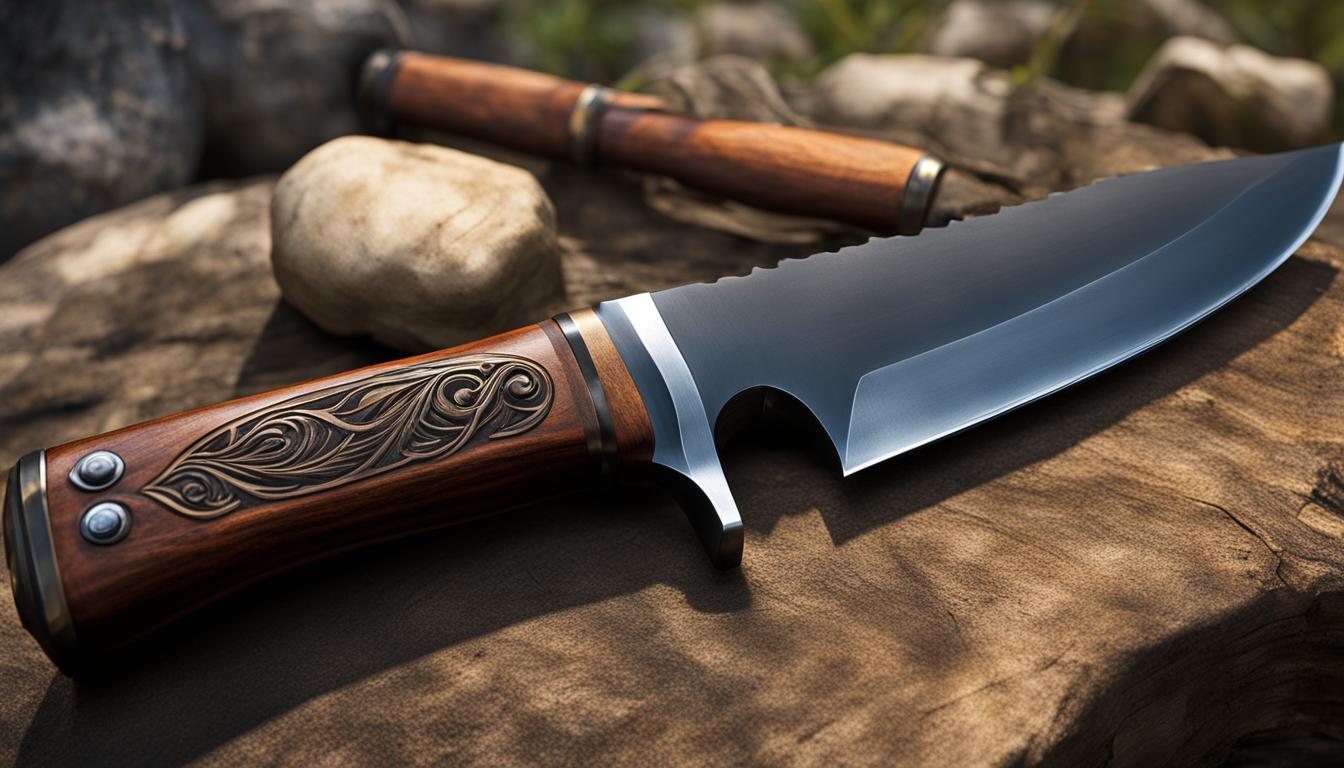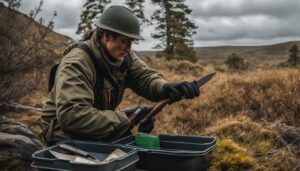As a hunter, I understand the importance of having the right gear for a successful hunting expedition. One crucial piece of equipment that can make a difference is a hunting knife. Not only does it aid in processing game, but it also ensures safety and efficiency in the field. In this comprehensive guide, I will provide you with all the information you need to choose the best hunting knife safeguards. From tips on selecting the right blade to understanding the essential features to consider, this guide will equip you with the knowledge necessary for a memorable and successful hunting experience.
Key Takeaways:
- Choosing the right hunting knife is crucial for a successful hunt.
- Consider the type of hunting knife that suits your specific needs, such as gut hook, skinning, folding, or fixed blade.
- Blade material, shape, and handle design are essential factors to consider when selecting a hunting knife.
- Ensure the hunting knife has safety features and accessories like a locking mechanism and a sheath for safe storage and transportation.
- Maintain and care for your hunting knife regularly to prolong its lifespan and optimize its performance.
Types of Hunting Knives
When it comes to hunting, having the right tools can make all the difference. One crucial tool for any hunter is a reliable hunting knife. However, not all hunting knives are created equal. There are different types of knives, each designed for specific tasks in the field. Understanding the different types of hunting knives is essential when choosing the right tool for your needs.
Gut Hook Knife
The gut hook knife features a curved blade with a sharpened hook on the spine. This type of knife is specifically designed for opening up the abdominal cavity of game animals without puncturing the internal organs. It allows for clean and precise cuts when field dressing the animal.
Skinning Knife
A skinning knife has a thin, curved blade that is ideal for efficiently removing the hide from the animal. This type of knife allows for smooth and controlled movements, making the skinning process easier and more efficient.
Folding Knife
A folding knife is a compact and versatile option that is convenient for carrying in a pocket. It typically features a folding blade that can be easily opened and closed. Folding knives are popular among hunters as they are easy to carry and can serve multiple purposes in the field.
Fixed Blade Knife
A fixed blade knife is a solid and durable option that does not fold. It offers increased strength and stability, making it suitable for heavier tasks such as field dressing and quartering game. Fixed blade knives are known for their reliability and durability, making them a popular choice among hunters.
https://www.youtube.com/watch?v=c19JgUob4iU
Choosing the right hunting knife is crucial for a successful hunting expedition. Understanding the different types of hunting knives available allows you to select the one that best suits your needs. Whether you opt for a gut hook knife, skinning knife, folding knife, or fixed blade knife, having the right tool in your arsenal will enhance your hunting experience and ensure efficiency in the field.
Choosing the Right Blade
When it comes to choosing the right blade for your hunting knife, several factors should be considered. The blade material is an important consideration, with stainless steel and carbon steel being the most common options.
Stainless steel blades offer excellent resistance to corrosion and require less maintenance, making them ideal for hunters who frequently encounter wet or humid conditions. On the other hand, carbon steel blades are known for their superior strength and edge retention, making them a preferred choice for heavy-duty tasks.
Blade shape is another crucial factor to consider. The drop point blade is one of the most versatile options, offering a robust tip for piercing and a large cutting surface for various hunting tasks. The clip point blade, on the other hand, provides excellent control and precision, making it suitable for detailed work. For efficient hide removal, a skinning blade with a curved edge is the top choice.
| Blade Type | Benefits |
|---|---|
| Stainless Steel | Durable and resistant to corrosion |
| Carbon Steel | Superior strength and edge retention |
| Drop Point Blade | Versatile and suitable for different hunting tasks |
| Clip Point Blade | Offers precision and control |
| Skinning Blade | Curved edge for efficient hide removal |
Choosing the right blade for your hunting knife is essential for optimal performance in the field. Consider your specific hunting needs and preferences, and select a blade that matches your requirements.
Handle and Grip
In order to ensure a safe and comfortable hunting experience, the handle of your hunting knife plays a crucial role. It is important to consider the handle material, design, and grip when choosing the right hunting knife for your needs.
The handle material can significantly impact the durability and performance of your knife. Common handle materials include wood, synthetic composites, and rubber. Wood handles provide a classic and aesthetic appeal, but may require more maintenance to prevent warping or cracking. Synthetic composites, on the other hand, offer durability and resistance to weather conditions. Rubber handles provide an excellent non-slip grip, ideal for wet or slippery environments.
Ergonomic design is another important factor to consider. An ergonomic handle is designed to fit comfortably in your hand, reducing fatigue and allowing for extended periods of use without discomfort. Look for hunting knives with contoured handles that conform to the natural shape of your hand.
A non-slip grip is essential for maintaining control and preventing accidents while using your hunting knife. Whether you are field dressing game or performing other tasks in the field, a secure grip ensures safe and precise handling. Consider hunting knives with textured or patterned handles that provide added friction and stability.
Hunting Knife Handle Materials
| Handle Material | Pros | Cons |
|---|---|---|
| Wood | Natural and aesthetically pleasing Tradition and craftsmanship Can be customized and engraved |
Requires regular maintenance Prone to warping or cracking Less durable compared to synthetic materials |
| Synthetic Composites | Durable and weather-resistant Lightweight and easy to clean Offers a wide range of designs and colors |
May lack the natural feel of wood Less traditional aesthetic appeal |
| Rubber | Provides excellent non-slip grip Resistant to water and weather conditions Shock absorbent for reduced hand fatigue |
May lack the aesthetics of other materials Requires proper maintenance to prevent degradation |
“The handle of a hunting knife is as important as the blade itself. It is essential to choose a handle material that offers durability, an ergonomic design for comfortable use, and a non-slip grip for safety in any hunting scenario.” – Anonymous
Hunting Knife Safety: Essential Precautions for a Safe Hunting Experience
When it comes to hunting knife safety, taking the necessary precautions is crucial for a safe and successful hunting experience. Properly equipping yourself with the right safety features and accessories can significantly reduce the risk of accidents and ensure that you can handle your hunting knife with confidence. In this section, I will discuss the key safety measures you should consider when using a hunting knife and the essential accessories that can enhance your safety in the field.
Safety Lock: Preventing Accidental Closure
A safety lock is an important feature to look for when choosing a hunting knife. This mechanism is designed to keep the blade securely in place, preventing accidental closure during use. Accidental closure can lead to serious injuries, so having a reliable safety lock provides an extra layer of protection and peace of mind. Make sure to check that the hunting knife you choose has a sturdy safety lock that is easy to engage and disengage to ensure maximum safety and convenience.
Sheath: Protecting Your Blade and Ensuring Safe Storage
A sheath is an essential accessory that not only protects the blade of your hunting knife but also ensures safe storage and transport. A well-designed sheath should securely hold the knife in place, preventing accidental cuts or injuries when not in use. Look for a sheath made from durable materials such as leather or synthetic composites, as these provide reliable protection and longevity. Additionally, some sheaths feature belt loops or attachment options, allowing you to carry your hunting knife conveniently on your person during your hunting expeditions.
Sharpening Tool: Maintaining Sharpness and Cutting Ability
A sharpening tool is a must-have accessory for every hunter. Keeping your hunting knife sharp is essential for optimal cutting performance and efficiency. Over time, the blade will naturally become dull through use, and a sharpening tool allows you to restore its sharpness easily. There are various sharpening tools available, such as sharpening stones, honing rods, or sharpening systems. Choose one that suits your preference and skill level, and regularly maintain the sharpness of your hunting knife to ensure clean and precise cuts.
By prioritizing hunting knife safety and investing in the right safety features and accessories, you can enjoy a safe and worry-free hunting experience. Remember to always handle your hunting knife responsibly and follow proper safety guidelines to minimize the risk of accidents in the field.
| Safety Feature | Description |
|---|---|
| Safety Lock | A mechanism that prevents accidental closure of the blade during use. |
| Sheath | A protective case that holds the blade and ensures safe storage and transport. |
| Sharpening Tool | An accessory used to maintain the sharpness and cutting ability of the hunting knife. |
Maintenance and Care
In order to ensure the longevity and optimal performance of your hunting knife, regular maintenance and care are essential. By following a few simple steps, you can keep your blade in top condition for all your hunting expeditions.
Cleaning the Blade
After each use, it is important to clean the blade thoroughly to remove any residue or debris. Use warm water and mild soap to gently scrub the blade with a soft cloth or sponge. Be sure to dry the blade completely to prevent any moisture from causing rust or corrosion. Avoid using harsh chemicals or abrasive cleaners, as they can damage the blade’s finish.
Lubricating the Blade
To prevent corrosion and keep the blade in optimal condition, it is recommended to lubricate the blade regularly with a rust-preventative oil. Apply a small amount of oil to a clean cloth and rub it onto the blade, making sure to cover the entire surface. This will create a protective barrier against moisture and help to maintain the blade’s sharpness.
Sharpening Techniques
Proper sharpening is crucial for maintaining the cutting ability of your hunting knife. There are various techniques you can use, depending on the type of blade and your personal preference. One common method is to use a sharpening stone, holding the blade at a consistent angle and making smooth strokes along the stone. Alternatively, you can use a honing rod to realign the edge of the blade. Remember to follow the manufacturer’s instructions and take your time to ensure a sharp and precise edge. Regular sharpening will not only enhance the performance of your knife but also ensure your safety while using it.
By following these maintenance and care tips, you can keep your hunting knife in top shape for all your hunting adventures. Proper cleaning, lubrication, and sharpening will not only prolong the life of your blade but also ensure that it performs optimally when you need it most. Remember, a well-maintained knife is a reliable tool and a valuable companion in the field.

Best Hunting Knife Safeguards for Different Hunting Scenarios
When it comes to hunting, different scenarios call for specific hunting knife safeguards. Whether you’re deer hunting, waterfowl hunting, big game hunting, turkey hunting, or engaging in general hunting, choosing the right knife can make all the difference in your success and efficiency in the field.
Hunting Knife Scenarios
In deer hunting, having the right tools for field dressing and processing game is crucial. A gut hook knife and a skinning knife are invaluable for these tasks. The gut hook knife allows you to open up the abdominal cavity without damaging the internal organs, while the skinning knife’s thin, curved blade makes removing the hide a breeze.
Waterfowl hunting requires a versatile knife that can handle general tasks and specific bird hunting needs. A folding knife is practical for various purposes, and a bird hunting knife with specialized features such as feather removal and cleaning capabilities is essential.
For big game hunting, a strong and durable fixed blade knife is a must. This type of knife offers the strength and reliability needed for heavy-duty tasks like field dressing and quartering game.
Turkey hunting calls for a compact and agile knife that allows for precise and quick cuts. A knife with a sturdy and sharp blade will ensure smooth and efficient processing of your turkey in the field.
In general hunting scenarios, it’s important to have a multi-purpose hunting knife that combines a reliable blade with a comfortable handle. This type of knife can handle a wide range of tasks, from field dressing to general camp chores.
| Hunting Scenario | Recommended Knife |
|---|---|
| Deer Hunting | Gut Hook Knife and Skinning Knife |
| Waterfowl Hunting | Versatile Folding Knife and Bird Hunting Knife |
| Big Game Hunting | Fixed Blade Knife |
| Turkey Hunting | Compact and Agile Knife |
| General Hunting | Multi-purpose Hunting Knife |
By selecting the appropriate hunting knife safeguards for your specific hunting scenario, you can enhance your experience, improve your efficiency, and ensure a successful harvest. Remember to prioritize safety and invest in high-quality gear that will serve you well on your hunting expeditions.


Conclusion and Final Thoughts
After exploring the various considerations involved in choosing the best hunting knife safeguards, it is clear that having the right gear is essential for a successful hunting expedition. As a hunter, investing in high-quality hunting knife gear is a crucial step towards ensuring both safety and efficiency in the field.
By carefully considering factors such as blade type, handle design, safety features, and maintenance requirements, you can find the perfect hunting knife to suit your specific needs. Prioritizing safety should always be at the forefront of your decision-making process, as it will contribute to a more enjoyable and secure hunting experience.
Remember that your hunting equipment is an investment, and it is worth selecting gear that will last for seasons to come. With the right hunting knife in hand, you can enhance your hunting expeditions and increase your chances of a successful harvest. So, gear up, stay safe, and happy hunting!
FAQ
What are the different types of hunting knives?
There are gut hook knives, skinning knives, folding knives, and fixed blade knives.
What should I consider when choosing the right blade for a hunting knife?
Factors to consider include blade material, such as stainless steel or carbon steel, and blade shape, such as drop point, clip point, or skinning.
What should I look for in the handle of a hunting knife?
Look for a durable handle material, such as wood or synthetic composites, with an ergonomic design for a comfortable and secure grip.
What safety features and accessories should I consider for a hunting knife?
Look for knives with safety locking mechanisms and a sheath for safe storage and transport. Consider investing in a sharpening tool for maintenance.
How do I properly maintain and care for a hunting knife?
Clean the blade after each use, lubricate it to prevent rust, and regularly sharpen it using appropriate techniques. Store the knife in a dry and secure place.
What type of hunting knife is best for different hunting scenarios?
For deer hunting, gut hook knives and skinning knives are essential. Waterfowl hunting may require a folding knife and a specialized bird hunting knife. Big game hunting calls for a fixed blade knife, while turkey hunting benefits from a compact and agile knife. A multi-purpose hunting knife is suitable for general hunting scenarios.





